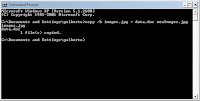
Below are some tips about the DIR command in MS DOS:
1. dir c:
This is the "base" that is used to display files and directories on drive C.
2. dir c: d:
Used to display files and directories on drive C and D.
3. dir / b / s
Used to display the directory and subdirectory to display the full path name.
4. dir / a
Used to show all files including the file system and hidden files (hidden).
To show all existing files on drive D using the following command: dir d: / a
5. dir / os
Used to display files and directories with the sequence starting from the file size to smallest file size with the largest. To reverse the order you can use the command: dir / os
You can change the parameter s on the above command with:
- N, the command dir / on: sequential names
- E, command dir / oe: sequential type of file
- D, the command dir / od: serial date
6. dir / p
To display the file and directory per "page".
For the other parameters of the dir command you can see her help with writing: dir /?







0 comments:
Post a Comment